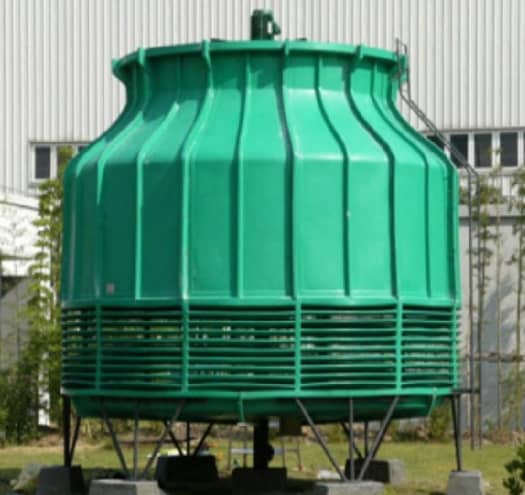The Brief Introduction of Cooling Tower
The cooling tower,uses water as a circulating coolant to absorb heat from a system. And discharge it into the atmosphere to reduce the water temperature.
Its use of water and air flow contact after the exchange of cold and heat to produce steam. And, steam volatilization to take away the heat to achieve evaporative heat dissipation. Following, heat transfer and radiation heat transfer principle to disperse industrial. or refrigeration air conditioning generated in the waste heat to reduce the water temperature of the evaporative heat dissipation device.
To ensure the normal operation of the system, the device generally barrel-shaped, so called cooling tower.

How it works
Equipment
Cooling tower an equipment that uses the contact of water and air to disperse the waste heat. General in industry or refrigeration and air conditioning through evaporation.
Basic principle
The basic principle of its work is:
After the dry air pumps from the fan, it enters the cooling tower from the inlet air network.
The high temperature water molecules with high partial pressure of saturated steam flow to the air with low pressure.
and the wet and hot water (high enthalpy value) poured into the tower by the self-seeded water system.
When water droplets and air contact, on the one hand due to the direct heat transfer of air and not.
on the other hand due to the pressure. difference between the surface of water steam and the air, evaporation phenomenon under the action of pressure.
brought to the current evaporation latent heat, the heat in the water is taken away by evaporation heat transfer, so as to achieve the purpose of cooling.
working process
The working process of the cooling tower takes the working process of the circular countercurrent cooling tower as an example.
the hot water autonomous machine room circulates the water pressure to the water sowing system of the cooling tower through the pump at a certain pressure through the pipeline.
cross throat, curved throat, and central throat, and the water is evenly spread on the filler through the small hole on the sowing pipe.
The dry air with low Han value enters the tower from the bottom of the air inlet net under the action of the fan
and the hot water flows through the surface of the packing to form a water film and the air for heat exchange.
The hot air with high humidity and high Han value is drawn from the top
and the cooling water drops into the bottom basin and flows into the main engine through the outlet pipe.
normal circumstances
Under normal circumstances, the air entering the tower is dry and low wet bulb temperature air, and there obviously a concentration difference and kinetic energy pressure difference of water molecules between water and air.
When the fan running, under the action of static pressure in the tower, the water molecules continue to evaporate into the air and become water vapor molecules, and the average kinetic energy of the remaining water molecules will be reduced, thus reducing the temperature of the circulating water.
analysis
From the above analysis, it can see that evaporation cooling has nothing to do with the temperature of the air (usually said dry bulb temperature) being lower or higher than the water temperature, as long as water molecules can continue to evaporate into the air, the water temperature will decrease.
However, the evaporation of water into the air does not go on indefinitely. When the air in contact with water not saturated, the water molecules continue to evaporate into the air, but when the air at the water-gas contact surface reaches saturation, the water molecules do not evaporate out, but are in a dynamic equilibrium state.
The number of water molecules that evaporate out is equal to the number of water molecules that return to the water from the air, and the water temperature remains the same. It can see that the drier the air in contact with water, the easier evaporation is, and the water temperature is easy to reduce.
The scope of application
The waste heat generated in industrial production or refrigeration process generally guided away by cooling water.
The role of the cooling tower- to carry out heat exchange between the cooling water with waste heat in the tower and the air.
so that the waste heat- transmitted to the air and dispersed into the atmosphere.
example
For example, in a thermal power plant, the boiler heats water into high temperature and high pressure steam, pushes the turbine to do work to make the generator generate electricity.
Then the waste steam after the steam turbine does work is discharged into the condenser. Finally, the cooling water exchanged to condense into water. and then the water pumped back to the boiler for recycling.
In this process, the waste heat of the lack of steam is transferred to the cooling water.
which increases the temperature of the water.
and the cooling water with the waste heat is heated in the cooling tower.
It is transferred to the air and discharged from the air duct into the atmospheric environment.
Cooling tower application: mainly used in air conditioning cooling system
- cold frozen series
- injection molding
- leather, foaming
- power generation,
- steam turbine,
- aluminum profile processing,
- air compressor,
- industrial water cooling and other fieleds,
- freezing,
- plastic chemical industry.
Learn more our project quality managemet, QAQC and third party inspection (TPI), NDT practices thru below link.
